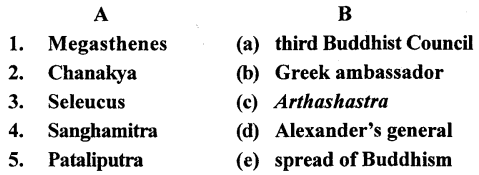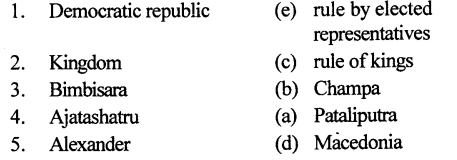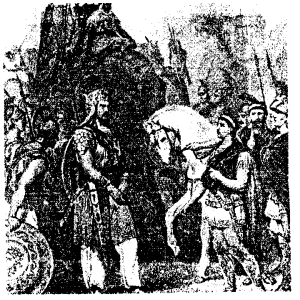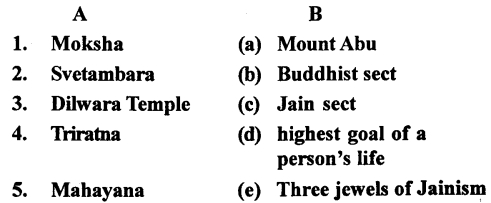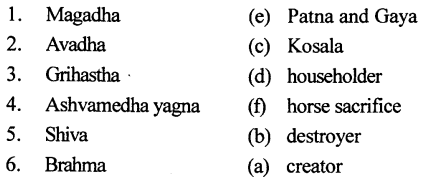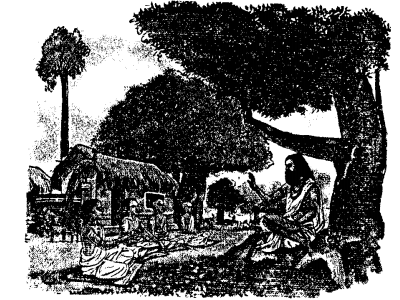The Trail History and Civics for Class 6 ICSE Solutions – The Mauryan Administration
ICSE SolutionsSelina ICSE SolutionsML Aggarwal Solutions
The Trail History and Civics for Class 6 ICSE Answers
Trail HistoryCivicsHistory & Civics Geography Biology Chemistry Physics Maths
Keywords
- Mantri parishad: It was the council of ministers who assisted the king.
- Kumaras: They were the princes of the royal family who were put in charge of important provinces.
- Grama: It means village. StupasThey are solid, semicircular, dome-shaped Buddhist ; structures which have some relics of Buddha at their base.
- Viharas: were Buddhist monasteries.
- Dharma chakras: are the wheels, carved on Ashoka’s Pillar at Samath. The wheel, representing motion and progress, is seen on the Indian national flag.
Exercises
A. Fill in the blanks:
- The king had supreme power. He was advised by the mantri parished.
- The provinces were divided into a number of districts which were further subdivided into nagaras and gramas.
- The capital city of Pataliputra was looked after by six committees. Each committee consisted of five members.
- The lion capital was adopted as the emblem of India in the year 1950.
- The last Mauryan emperor was killed by Pushyamitra Sunga the founder of the Sunga dynasty.
B. Match the following:
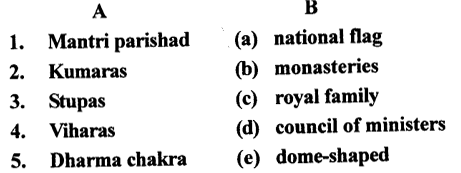
Answer:
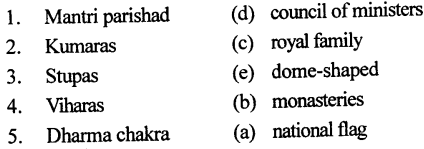
C. Choose the correct answer:
1. The Mauyran empire was divided into provinces/districs/ nagaras which were placed under the control of kumaras.
Ans. The Mauyran empire was divided into provinces which were placed under the control of kumaras.
2. Mauryan art was greatly influenced by Hinduism/ Buddhism/Taoism.
Ans. Mauryan art was greatly influenced by Buddhism.
3. The most famous Ashoka Pillar is at Sarnath/Sanchi/ Pataliputra.
Ans. The most famous Ashoka Pillar is at Sarnath.
4. The Mauryans had trade relations with Sri Lanka/ China/Mesopotamia.
Ans: The Mauryans had trade relations with Sri Lanka.
5. The last Mauryan ruler was Chandragupta Maurya/ Brihadratha/Ashoka.
Ans: The last Mauryan ruler was Brihadratha.
D. State whether the following are true or false.
- The Mauryan administration was based on the guidelines laid down in the Indika.
False.
Correct: The Mauryan administration was based on the guidelines laid down in the Arthashastra. - There was no spy system in the Mauryan empire.
False.
Correct: There was spy system in the Mauryan empire. - Pataliputra was a magnificent walled city.
True. - The relics of Buddha were kept at the base of the stupa.
True. - The chief occupation of the people during the Mauryan period was mining.
False.
Correct: The chief occupation of the people during the Mauryan period was agriculture.
E. Answer the following questions in one or two words/ sentences:
Question 1.
What was the role of the mantri parishad in the Mauryan administration?
Answer:
Mantri parishad was the council of ministers who assisted the king.
Question 2.
Name the capital city of the Mauryan empire.
Answer:
The capital city of the Mauryan empire was Pataliputra.
Question 3.
Mention two important features of stupas built during the Mauryan period.
Answer:
They are solid, semicircular, dome-shaped Buddhist structures which were made of stone and bricks, They have some relics of Buddha at their base.
Question 4.
Which Buddhist stupa is an outstanding specimen of Mauryan architecture?
Answer:
The stupa of Sanchi is an outstanding specimen of Mauryan architecture.
Question 5.
Which Mauryan sculpture was adopted as India’s national emblem is 1950?
Answer:
The lion capital was adopted as the national emblem of India in 1950.
Question 6.
Name any two foreign countries with whom the Mauryans had trade relations.
Answer:
Mauryans had trade relations with Sri Lanka, Egypt and Greece.
F. Answer the following questions briefly:
Question 1.
Mention the main features of Mauryan administration with reference to (i) committees and (it) spy system.
Answer:
- Committees: There were six committees, each consisting of five members. Each committee was incharge of a particular department such as industries, registration of births and deaths, care of foreigners, and trade and commerce. These 30 members also looked after common problems related to health, sanitation, education, etc.
- Spy system: The king had an elaborate spy system which kept him informed about his viceroys and officials as well as what was going on inside and outside his kingdom.
Question 2.
Describe the distinctive features of Ashokan pillars.
Answer:
Monolithic pillars, inscribed with the edicts of Ashoka, are the best examples of the remarkable skill and quality of Mauryan artists. The surface of the stone pillars were highly polished. The pillar at Samath is the most famous. The lion capital of this pillar is the most magnificent piece of sculpture of the Mauryan period.
Question 3.
Give an account of the economic conditions under the Mauryan rulers.
Answer:
The Mauryan rulers had unified the country and brought peace and stability. These favourable conditions promoted the growth of the economy and made the empire rich and prosperous.
Agriculture was the main occupation of the people. Farmers were encouraged to bring more land under cultivation. Irrigation facilities were provided to them. Land revenue was collected from the farmers and it was the chief source of income for the king.
Question 4.
What were the causes for the decline of the Mauryan empire?
Answer:
These were following reasons for decline of Mauryan empire.
- Ashoka’s successors were weak and inefficient.
- The empire was too vast and it was not easy to control the far-flung territories.
- In the absence of a strong central authority, the provincial viceroys declared themselves independent.
- The expense of maintaining a large standing army and an elaborate administrative system was a heavy drain on the state treasury.
G Picture study.
This is an important monument of the ancient period but is relevant even today.
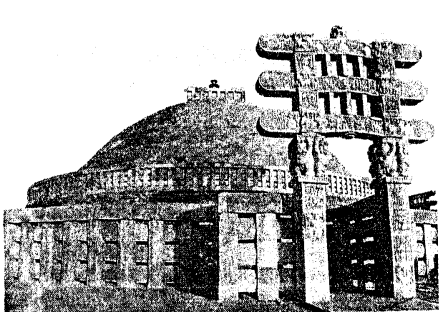
Question 1.
Identify the monuments.
Answer:
The Buddhist stupa at Sanchi, in Madhya Pradesh.
Question 2.
Describe its important features.
Answer:
Mauryan art was greatly influenced by Buddhism. Ashoka is supposed to have built 84,000 stupas throughout the kingdom. Stupas are solid, semicircular, dome-like structures made of stones and bricks. Relics of Buddha, such as his hair, tooth, etc., were kept at the base of the stupa. The stupa of Sanchi is an outstanding specimen of Mauryan architecture.
Question 3.
In which century and by whom was it built ?
Answer:
The Great Stupa at Sanchi was built by the emperor Ashoka in the 3rd century BCE and is one of the finest examples of Mauryan architecture.
OTHER IMPORTANT QUESTIONS
Question 1.
How many committees were set up for the administration of Pataliputra? Name any three departments that were looked after by these committees.
Answer:
Six committees were set up for the adminstration for Patliputra.
- Sanitation
- Trade and commerce
- Public utility were three departments that were looked after by these committees.
Question 2.
Mention two important features of each of the following:
- Monolithic pillars
- Lion capital
Answer:
- Monolithic pillars— Mautryas built many Monolithic pillars, inscribed with the edicts of Ashoka. They are the best examples of the remarkable skill and quality of Mauryan artists. The surfaces of the stone pillars were highly polished. The Pillar at Samath is the most famous.
- Lion capital— The lion capital of the pillar is the most magnificent piece of sculpture of the Mauryan period. The lion capital was adopted as the national emblem of India in 1950. A picture of the lion capital can be seen on Indian currency notes.
Question 3.
Mention three important occupations of the people during the Mauryan period.
Answer:
Agriculture was main occupation of the people. Other occupations included mining, forestry and carpentry during the Mauryan Period.
